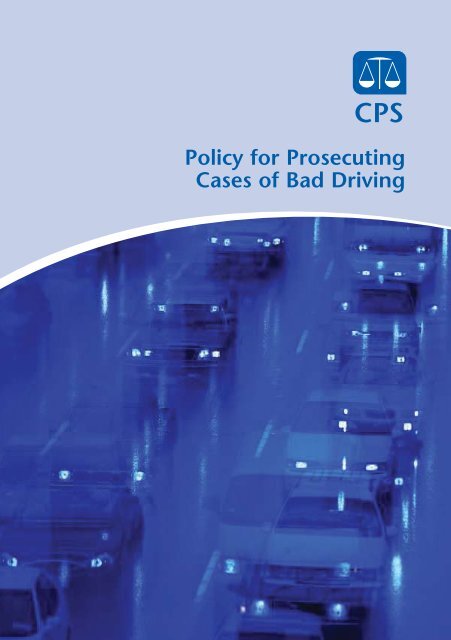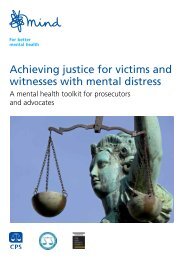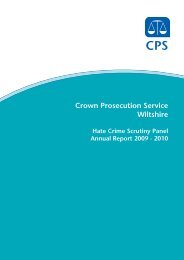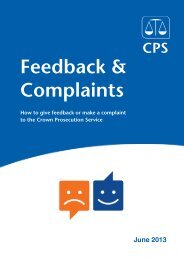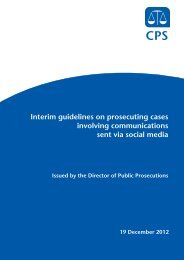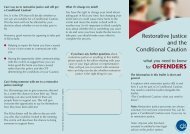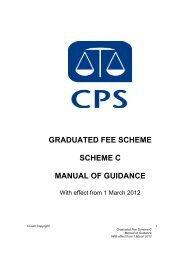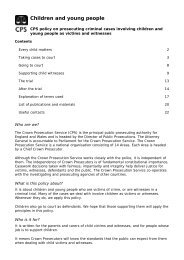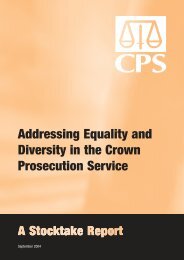Policy for prosecuting cases of bad driving - Crown Prosecution ...
Policy for prosecuting cases of bad driving - Crown Prosecution ...
Policy for prosecuting cases of bad driving - Crown Prosecution ...
Create successful ePaper yourself
Turn your PDF publications into a flip-book with our unique Google optimized e-Paper software.
<strong>Policy</strong> <strong>for</strong> ProsecutingCases <strong>of</strong> Bad Driving
<strong>Policy</strong> <strong>for</strong> Prosecuting Cases <strong>of</strong> Bad DrivingContentsIntroduction 2What is <strong>bad</strong> <strong>driving</strong>? 4The role <strong>of</strong> the <strong>Crown</strong> <strong>Prosecution</strong> Service 10The Code <strong>for</strong> <strong>Crown</strong> Prosecutors 11Prosecuting <strong>cases</strong> <strong>of</strong> <strong>bad</strong> <strong>driving</strong> 15Victim and witness care 28Sentencing 33Conclusion 35Annex A – Support organisations 361
<strong>Policy</strong> <strong>for</strong> Prosecuting Cases <strong>of</strong> Bad DrivingPUBLIC STATEMENTIntroduction1.1 This document explains the way in which we, the <strong>Crown</strong><strong>Prosecution</strong> Service (CPS), deal with <strong>cases</strong> involving <strong>bad</strong><strong>driving</strong>. It supplements and is subordinate to the Code <strong>for</strong><strong>Crown</strong> Prosecutors.1.2 Bad <strong>driving</strong> resulting in death or injury has devastatingconsequences <strong>for</strong> victims and their families and friends,and it is important that justice is seen to be done in <strong>cases</strong>where this has happened.1.3 The CPS is committed to ensuring that in such <strong>cases</strong> ourprosecutors reach the correct charging decisions, so thatthe right person is prosecuted <strong>for</strong> the right <strong>of</strong>fence in theright court.1.4 For this to be achieved these decisions must be in line withcurrent law, but also, where it is just and lawful to do so,they should reflect changing public attitudes to <strong>bad</strong> <strong>driving</strong>and the desire <strong>of</strong> victims, or their families, friends and thepublic, to see that justice is done in these <strong>cases</strong>.1.5 In 2002 Her Majesty’s CPS Inspectorate (HMCPSI)undertook a review <strong>of</strong> the way in which the CPS washandling road traffic <strong>cases</strong> involving fatalities. That reviewfound that in the vast majority <strong>of</strong> <strong>cases</strong> under review thecorrect charge was chosen by the CPS 1 .2
<strong>Policy</strong> <strong>for</strong> Prosecuting Cases <strong>of</strong> Bad Driving1.6 In 2006 the Director <strong>of</strong> Public <strong>Prosecution</strong>s (DPP)acknowledged that, notwithstanding the findings <strong>of</strong> theHMCPSI report, there were occasions where victims or theirfamilies and friends did not agree with the decisions madeby the CPS or found them hard to accept or understand.1.7 Following a public consultation carried out by the HomeOffice in 2005, Parliament passed the Road Safety Act2006, which will introduce new <strong>of</strong>fences <strong>of</strong> causing deathby careless <strong>driving</strong> and causing death while <strong>driving</strong>unlawfully on a road 2 .1.8 The DPP decided that the time was right <strong>for</strong> the CPS toreview its prosecution policies and procedures <strong>for</strong> dealingwith <strong>cases</strong> <strong>of</strong> <strong>bad</strong> <strong>driving</strong>, and that this review should bein<strong>for</strong>med by a wide public consultation, which waslaunched in December 2006 3 .1.9 The purpose <strong>of</strong> the consultation was to open up the CPSpractices and procedures and to explain how CPSprosecutors reach their decisions in these <strong>cases</strong>, becausethe CPS wants the public to have confidence in thedecisions that we make.1A Report on the Thematic Review <strong>of</strong> the Advice Conduct and <strong>Prosecution</strong> by the<strong>Crown</strong> <strong>Prosecution</strong> Service <strong>of</strong> Road Traffic Offences involving Fatalities in Englandand Wales – available from the HMCPSI website (www.hmcpsi.gov.uk)2Sections 20 and 21 <strong>of</strong> the Road Safety Act 2006. These sections are not in <strong>for</strong>ce atthe time <strong>of</strong> writing.3Prosecuting Bad Driving – A Consultation on CPS <strong>Policy</strong> and Practice3
<strong>Policy</strong> <strong>for</strong> Prosecuting Cases <strong>of</strong> Bad Driving1.10 There were 139 responses to the consultation, showinghow deeply people care about the consequences <strong>of</strong> <strong>bad</strong><strong>driving</strong> and how its consequences, especially where a lovedone has been killed or seriously injured, causeunimaginable distress.1.11 The issues raised by the consultation attracted a widerange <strong>of</strong> views, all <strong>of</strong> which have been taken fully intoaccount in the preparation <strong>of</strong> this policy. The content <strong>of</strong>the policy, however, is the responsibility <strong>of</strong> the CPS alone.1.12 The CPS is not the only agency that deals with <strong>cases</strong>involving <strong>bad</strong> <strong>driving</strong>. The police, the criminal courts,magistrates and judges all have roles to play in promotinggreater confidence in the criminal justice system. We shallwork with our partner agencies to ensure that justice isdone in these <strong>cases</strong>.What is Bad Driving?2.1 There is no statutory definition <strong>of</strong> <strong>bad</strong> <strong>driving</strong>, but there area number <strong>of</strong> general <strong>of</strong>fences that directly concern or relateto the way in which a vehicle is driven. The elements <strong>of</strong>each <strong>of</strong>fence and levels <strong>of</strong> punishment are set out below.Murder2.2 Where there is evidence that a motorist killed anotherperson intending to kill or cause grievous bodily harm, heor she will be liable to prosecution <strong>for</strong> murder.4
<strong>Policy</strong> <strong>for</strong> Prosecuting Cases <strong>of</strong> Bad Driving2.3 The <strong>of</strong>fence is triable only on indictment 4 and carries amandatory sentence <strong>of</strong> life imprisonment.Manslaughter2.4 Where a killing is involuntary, that is to say, where it wasnot intended, it may amount to manslaughter.2.5 Manslaughter is triable only on indictment and carries amaximum sentence <strong>of</strong> life imprisonment.2.6 Disqualification from <strong>driving</strong> <strong>for</strong> a minimum period <strong>of</strong> 2years followed by an extended retest is mandatory.Causing death by dangerous <strong>driving</strong>2.7 Section 1 <strong>of</strong> the Road Traffic Act 1988 provides that the<strong>of</strong>fence is committed when the <strong>driving</strong> was the cause <strong>of</strong> adeath <strong>of</strong> another and it was dangerous within themeaning <strong>of</strong> Section 2A <strong>of</strong> the Road Traffic Act 1988.2.8 The <strong>of</strong>fence is triable only on indictment and carries amaximum sentence <strong>of</strong> 14 years’ imprisonment.2.9 Disqualification from <strong>driving</strong> <strong>for</strong> a minimum period <strong>of</strong> 2years followed by an extended retest is mandatory.4Trial on indictment means trial at the <strong>Crown</strong> Court be<strong>for</strong>e a judge and jury.5
<strong>Policy</strong> <strong>for</strong> Prosecuting Cases <strong>of</strong> Bad DrivingCausing death by careless <strong>driving</strong> while under theinfluence <strong>of</strong> drink or drugs2.10 Section 3A <strong>of</strong> the Road Traffic Act 1988 provides that this<strong>of</strong>fence is committed when the <strong>driving</strong> was without duecare and attention or without reasonable consideration <strong>for</strong>other road users; the <strong>driving</strong> has caused the death <strong>of</strong>another person and the driver is either unfit through theconsumption <strong>of</strong> drink or drugs, or the alcoholconcentration in his body is over the prescribed limit, orthere has been a failure to provide a specimen <strong>of</strong>breath/blood/urine in pursuance <strong>of</strong> the law.2.11 The <strong>of</strong>fence is triable only on indictment and carries amaximum penalty <strong>of</strong> 14 years’ imprisonment.2.12 Disqualification from <strong>driving</strong> <strong>for</strong> a minimum period <strong>of</strong> 2years followed by an extended retest is mandatory.Causing death by careless or inconsiderate <strong>driving</strong> 52.13 Section 2B <strong>of</strong> the Road Traffic Act 1988 6 provides that this<strong>of</strong>fence is committed when the <strong>driving</strong> is without due careand attention, or without reasonable consideration <strong>for</strong>other road users; and the <strong>driving</strong> has caused the death <strong>of</strong>another person.2.14 The <strong>of</strong>fence can be tried either in a magistrates’ court or inthe <strong>Crown</strong> Court. On indictment it carries a maximumsentence <strong>of</strong> 5 years’ imprisonment.5The legislation creating this <strong>of</strong>fence is not in <strong>for</strong>ce at the time <strong>of</strong> writing.6Inserted by Section 20 <strong>of</strong> the Road Safety Act 2006.6
<strong>Policy</strong> <strong>for</strong> Prosecuting Cases <strong>of</strong> Bad Driving2.15 Disqualification from <strong>driving</strong> <strong>for</strong> a minimum <strong>of</strong> 12 monthsis mandatory.Causing death by <strong>driving</strong> unlicensed, uninsured ordisqualified 72.16 Section 3ZB <strong>of</strong> the Road Traffic Act 1988 8 provides thatthis <strong>of</strong>fence is committed when a driver causes the death<strong>of</strong> another person by <strong>driving</strong> on a road when unlicensed,uninsured or disqualified from holding or obtaining a<strong>driving</strong> licence.2.17 The <strong>of</strong>fence can be tried either in a magistrates’ court or inthe <strong>Crown</strong> Court. On indictment it carries a maximumsentence <strong>of</strong> 2 years’ imprisonment.2.18 Disqualification from <strong>driving</strong> <strong>for</strong> a minimum <strong>of</strong> 12 monthsis mandatory.Dangerous <strong>driving</strong>2.19 Section 2A <strong>of</strong> the Road Traffic Act 1988 provides that aperson is to be regarded as <strong>driving</strong> dangerously if the wayhe or she drives falls far below what would be expected <strong>of</strong>a competent and careful driver and it would be obvious toa competent and careful driver that <strong>driving</strong> in that waywould be dangerous. A person is also to be regarded as<strong>driving</strong> dangerously if it would be obvious to a competentand careful driver that <strong>driving</strong> the vehicle in its currentstate would be dangerous.7The legislation creating this <strong>of</strong>fence is not in <strong>for</strong>ce at the time <strong>of</strong> writing.8Inserted by Section 21 <strong>of</strong> the Road Safety Act 2006.7
<strong>Policy</strong> <strong>for</strong> Prosecuting Cases <strong>of</strong> Bad Driving2.20 The <strong>of</strong>fence can be tried either in a magistrates’ court or inthe <strong>Crown</strong> Court. On indictment it carries a maximumsentence <strong>of</strong> 2 years’ imprisonment.2.21 Disqualification from <strong>driving</strong> <strong>for</strong> a minimum period <strong>of</strong> 12months followed by an extended retest is mandatory.Careless or inconsiderate <strong>driving</strong>2.22 Careless <strong>driving</strong> is an <strong>of</strong>fence contrary to Section 3 <strong>of</strong> theRoad Traffic Act 1988. S3ZA <strong>of</strong> that Act 9 defines careless<strong>driving</strong> as <strong>driving</strong> that falls below what would be expected<strong>of</strong> a competent and careful driver.2.23 Inconsiderate <strong>driving</strong> requires the prosecution to prove inaddition that other persons were inconvenienced by the<strong>driving</strong>.2.24 The <strong>of</strong>fence can be tried only in a magistrates’ court.2.25 The <strong>of</strong>fence is not imprisonable. Disqualification isdiscretionary.Wanton and furious <strong>driving</strong>2.26 Wanton and furious <strong>driving</strong> is an old <strong>of</strong>fence – predatingthe invention <strong>of</strong> the internal combustion engine –contained in Section 35 <strong>of</strong> the Offences Against the PersonAct 1861. The prosecution must prove that the defendantdrove dangerously (careless <strong>driving</strong> is insufficient) andcaused some injury to another person.9Inserted by Section 30 <strong>of</strong> the Road Safety Act 2006.8
<strong>Policy</strong> <strong>for</strong> Prosecuting Cases <strong>of</strong> Bad Driving2.27 The <strong>of</strong>fence is not limited to a road or other public placeand is there<strong>for</strong>e useful <strong>for</strong> <strong>prosecuting</strong> <strong>cases</strong> where the<strong>bad</strong> <strong>driving</strong> occurred <strong>of</strong>f-road.2.28 The <strong>of</strong>fence is triable only on indictment and carries amaximum sentence <strong>of</strong> 2 years' imprisonment.2.29 Penalty points and discretionary disqualification are nowavailable to courts 10 .Aggravated Vehicle Taking2.30 This <strong>of</strong>fence was introduced in 1992 in response to publicconcern about what had become known as ‘joyriding’.Be<strong>for</strong>e 1992, it was an <strong>of</strong>fence under Section 12 <strong>of</strong> theTheft Act 1968 to take a vehicle without the consent <strong>of</strong>the owner, or anyone else able to give permission onbehalf <strong>of</strong> the owner. The <strong>of</strong>fence also covered those notactually responsible <strong>for</strong> taking the vehicle, but who drovethe vehicle, or allowed themselves to be carried in it afterit was taken, knowing that it had been taken withoutpermission. It is still an <strong>of</strong>fence.2.31 However, the original <strong>of</strong>fence did not take into accountany <strong>bad</strong> <strong>driving</strong> <strong>of</strong> the vehicle after it had been unlawfullytaken, or the consequences that could follow from thevehicle being driven. The aggravated <strong>of</strong>fence wasintroduced to deal with this.10Section 28 <strong>of</strong> the Road Safety Act 2006.9
<strong>Policy</strong> <strong>for</strong> Prosecuting Cases <strong>of</strong> Bad Driving2.32 It can be found in Section 12A <strong>of</strong> the Theft Act 1968 andis committed if, after the vehicle is unlawfully taken butbe<strong>for</strong>e it is recovered, any one or more <strong>of</strong> the followingoccurs:• the vehicle is driven dangerously on a road or otherpublic place;• owing to the <strong>driving</strong> <strong>of</strong> the vehicle, a collision occurs bywhich injury is caused to any person;• owing to the <strong>driving</strong> <strong>of</strong> the vehicle, a collision occurs bywhich damage is caused to any property, other thanthe vehicle;• damage is caused to the vehicle.2.33 The <strong>of</strong>fence can be tried in the magistrates’ court or in the<strong>Crown</strong> Court. At the <strong>Crown</strong> Court the maximum sentenceis normally 2 years’ imprisonment, except where anycollision has caused the death <strong>of</strong> the victim, in which casethe maximum sentence is 14 years’ imprisonment.2.34 Disqualification from <strong>driving</strong> <strong>for</strong> a minimum period <strong>of</strong> 12months is obligatory.The role <strong>of</strong> the CPS3.1 It is the responsibility <strong>of</strong> the police to investigateallegations <strong>of</strong> crime and to gather evidence about whatoccurred.3.2 It is the responsibility <strong>of</strong> the CPS to decide charges in all10
<strong>Policy</strong> <strong>for</strong> Prosecuting Cases <strong>of</strong> Bad Drivingbut minor and routine <strong>cases</strong> and our prosecutors will workwith the police to ensure that <strong>bad</strong> <strong>driving</strong> <strong>cases</strong> areidentified as early as possible so that the correct chargingdecision can be made.The Code <strong>for</strong> <strong>Crown</strong> Prosecutors4.1 The way in which we reach our decisions about whether toprosecute is set out in the Code <strong>for</strong> <strong>Crown</strong> Prosecutors.This document is issued by the DPP. It is updated regularlyso that it reflects current practice. The Code is a publicdocument. Copies are available from CPS CommunicationsBranch, 50 Ludgate Hill, London EC4M 7EX or from localCPS <strong>of</strong>fices, or from our website.http://www.cps.gov.uk/victims_witnesses/code.html4.2 We review the <strong>cases</strong> that are referred to us in line with theFull Code Test that is set out in the Code. The test has twostages 11 . The first stage is consideration <strong>of</strong> the evidenceand the second concerns the public interest.The first stage – the evidential stage4.3 <strong>Crown</strong> Prosecutors must first be satisfied that there isenough evidence to provide a “realistic prospect <strong>of</strong>11At an early stage where not all <strong>of</strong> the evidence has been obtained but a decision tocharge cannot be delayed because it is not appropriate to bail the defendant,prosecutors may apply what is known as the Threshold Test. However, once all theevidence has been received the final decision must be made according to the FullCode Test.11
<strong>Policy</strong> <strong>for</strong> Prosecuting Cases <strong>of</strong> Bad Drivingconviction against each defendant on each charge”. Thismeans that a jury or bench <strong>of</strong> magistrates, properlydirected in accordance with the law, is more likely than notto convict the defendant <strong>of</strong> the charge alleged.4.4 The evidential standard that we apply is there<strong>for</strong>e differentfrom the one that the court applies be<strong>for</strong>e it may convict adefendant. This is why not all <strong>cases</strong> that are prosecutedresult in a conviction. Just because a case may pass theevidential stage in the Full Code Test does not necessarilymean that the case will result in a conviction. It is <strong>for</strong> thecourt to decide whether a defendant is guilty based uponthe evidence that it hears or reads.4.5 If the case does not pass the evidential stage based on thestrength <strong>of</strong> the evidence, it must not go ahead, no matterhow important or serious it may be. This is because wehave reached the view that the court is not likely to convictthe defendant <strong>of</strong> the crime alleged on the evidence wehave. In such <strong>cases</strong>, it is wrong to prosecute the defendantand it is wrong to raise the expectations <strong>of</strong> victims andwitnesses when we do not believe that a conviction islikely.The second stage – the public interest stage4.6 If the case does pass the evidential stage, we must thendecide if a prosecution is needed in the public interest. Aprosecution will usually take place “unless there are publicinterest factors tending against prosecution which clearlyoutweigh those tending in favour”.12
<strong>Policy</strong> <strong>for</strong> Prosecuting Cases <strong>of</strong> Bad Driving4.7 We regard all <strong>bad</strong> <strong>driving</strong> as serious, particularly where ithas led directly to the death or serious injury <strong>of</strong> anotherperson. As a result, the public interest in <strong>cases</strong> <strong>of</strong> <strong>bad</strong><strong>driving</strong>, where death or serious injury has occurred, willalmost always be in favour <strong>of</strong> a prosecution.4.8 However, there will always be <strong>cases</strong> where we decide thatit is not in the public interest to prosecute.4.9 Although we prosecute <strong>cases</strong> on behalf <strong>of</strong> the public atlarge and not just in the interests <strong>of</strong> any particularindividual, we always think very carefully about theinterests <strong>of</strong> the victim and their family when we decidewhere the public interest lies 12 .4.10 It is not always easy to strike this balance. The views <strong>of</strong> thevictim and their family are important, but they cannot bethe final word on the subject <strong>of</strong> a prosecution.Nearest and Dearest Cases4.11 In the past, the CPS adopted a different approach in <strong>cases</strong>where a death has occurred and the deceased was in aclose personal or family relationship with the driver. It wasbased on the principle that the driver has suffered suchenormous personal loss that it would be oppressive andinsensitive to prosecute the driver <strong>for</strong> the <strong>bad</strong> <strong>driving</strong><strong>of</strong>fence that led to the death.12The Code <strong>for</strong> <strong>Crown</strong> Prosecutors Paras 5.12 & 5.13.13
<strong>Policy</strong> <strong>for</strong> Prosecuting Cases <strong>of</strong> Bad Driving4.12 While we must always be able to exercise discretion in<strong>cases</strong> where prosecution would be oppressive orinsensitive, we believe that the public interest will normallydemand that a prosecution takes place in <strong>cases</strong> <strong>of</strong> causingdeath by dangerous <strong>driving</strong> or causing death by careless<strong>driving</strong> when under the influence <strong>of</strong> drink or drugs orfailing to provide a specimen, and that is now our policy inthese <strong>cases</strong>.4.13 The Road Safety Act 2006 13 introduces new <strong>of</strong>fences <strong>of</strong>causing death by careless <strong>driving</strong> and causing death by<strong>driving</strong> whilst uninsured, disqualified or unlicensed. Inthese <strong>cases</strong> we may exercise our discretion not toprosecute in <strong>cases</strong> where the degree <strong>of</strong> culpability on thepart <strong>of</strong> the driver is low, or where the circumstances <strong>of</strong> thecase would make it unjust to prosecute.4.14 In such <strong>cases</strong>, we may consider whether, <strong>for</strong> example, thestandard <strong>of</strong> <strong>driving</strong> fell below that required by the law onlyas a result <strong>of</strong> a true error <strong>of</strong> judgement.4.15 Where the illegality arose as a result <strong>of</strong> a genuine mistakeon the part <strong>of</strong> the driver, <strong>for</strong> example, a mistaken beliefthat he/she was insured, it may not necessarily be in thepublic interest to prosecute the driver where the deceasedwas a close relative or friend.13As at 6.12.07 these provisions were not in <strong>for</strong>ce.14
<strong>Policy</strong> <strong>for</strong> Prosecuting Cases <strong>of</strong> Bad DrivingProsecuting <strong>cases</strong> <strong>of</strong> <strong>bad</strong> <strong>driving</strong>5.1 We will adopt a proactive approach to seeking furtherin<strong>for</strong>mation from the police be<strong>for</strong>e a charging decision ismade. In all <strong>cases</strong>, prosecutors should liaise directly withthe <strong>of</strong>ficer in the case to make sure all available evidencehas been obtained and sent to the CPS so that we mayfully review the case. If necessary, we will advise the policeto follow up other lines <strong>of</strong> enquiry.CPS Charging Practice5.2 All <strong>Crown</strong> Prosecutors must apply the Code <strong>for</strong> <strong>Crown</strong>Prosecutors when considering charges. As we have seen,the prosecutor must consider whether there is sufficientevidence <strong>for</strong> a realistic prospect <strong>of</strong> conviction, bearing inmind the very high standard <strong>of</strong> pro<strong>of</strong> applied in thecriminal courts; and, if there is sufficient evidence, whetheror not it is in the public interest to proceed with the case.5.3 The charges that we decide on in any prosecution shouldalways reflect the circumstances <strong>of</strong> the <strong>of</strong>fence. Thecharges must help us to present the case clearly and simplyand they must give the court the power to impose asuitable sentence.Manslaughter5.4 An <strong>of</strong>fence <strong>of</strong> manslaughter may arise in two differentways: unlawful act manslaughter and gross negligencemanslaughter.15
<strong>Policy</strong> <strong>for</strong> Prosecuting Cases <strong>of</strong> Bad Driving5.5 In very general terms, unlawful act manslaughter can applywhere a vehicle is deliberately used as a weapon <strong>of</strong> assault.Gross negligence manslaughter can be applicable to asituation where there is no intent to use the vehicle as aweapon <strong>of</strong> assault, but the standard <strong>of</strong> <strong>driving</strong> falls so farbelow the required standard that there is a serious andobvious risk <strong>of</strong> death and the conduct <strong>of</strong> the defendant, inall the circumstances, is ‘so reprehensible as to amount togross negligence’ 14 .Unlawful act manslaughter5.6 It must be proved that:• the defendant’s act caused the death <strong>of</strong> the victim;• the defendant’s act constituted a criminal <strong>of</strong>fence initself;• the defendant had the mens rea appropriate to theunlawful act which caused the victim’s death; and• the defendant’s unlawful act is objectively recognised ashaving put the victim at risk <strong>of</strong> some physical harm,albeit not necessarily serious harm.5.7 Unlawful act manslaughter will be considered the mostappropriate charge when there is evidence to prove that avehicle was used as an instrument <strong>of</strong> attack (but where thenecessary intent <strong>for</strong> murder was absent), or to cause fright,and death resulted.14R v Misra & Srivastava [2005] 1 Cr. App. R. 21 para 48.16
<strong>Policy</strong> <strong>for</strong> Prosecuting Cases <strong>of</strong> Bad Driving5.8 Unlawful act manslaughter can occur in a variety <strong>of</strong> ways.For example, a driver may deliberately drive at a person orgroup <strong>of</strong> people with the intention <strong>of</strong> causing them to fearbeing struck by the vehicle. The driver may not actuallyintend to hit them with the car, but if he/she does so andsomeone is killed as a result, he/she may be guilty <strong>of</strong>unlawful act manslaughter. If someone is injured, thedefendant may be prosecuted <strong>for</strong> an assault.5.9 There is a difference between these <strong>cases</strong> and <strong>bad</strong> <strong>driving</strong><strong>cases</strong> where a death has occurred as a result <strong>of</strong> <strong>driving</strong>that is unlawful only because <strong>of</strong> the negligent manner <strong>of</strong>its per<strong>for</strong>mance 15 .5.10 In <strong>cases</strong> where a death has occurred as a result <strong>of</strong> <strong>bad</strong><strong>driving</strong> and it is clear that the standard <strong>of</strong> <strong>driving</strong> has beengrossly negligent on the part <strong>of</strong> the driver, a charge <strong>of</strong>gross negligence manslaughter may be the correct charge,as explained below.Gross negligence manslaughter5.11 To prove a charge based on gross negligencemanslaughter, the prosecution must show that thedefendant owed the victim a duty <strong>of</strong> care; that the <strong>driving</strong>caused the victim’s death; that the <strong>driving</strong> fell far belowthe minimum acceptable standard <strong>of</strong> <strong>driving</strong>; that therewas an obvious and serious risk <strong>of</strong> death; and that theconduct <strong>of</strong> the defendant can, in all the circumstances, bedescribed as ‘reprehensible’.15Andrews v DPP [1937] AC 576.17
<strong>Policy</strong> <strong>for</strong> Prosecuting Cases <strong>of</strong> Bad Driving5.12 Some sections <strong>of</strong> the public consider that we should <strong>of</strong>tencharge gross negligence manslaughter instead <strong>of</strong> causingdeath by dangerous <strong>driving</strong>.5.13 There are two arguments put <strong>for</strong>ward to support this view:• first, that the public is now increasingly less tolerant <strong>of</strong><strong>bad</strong> <strong>driving</strong> and convictions <strong>for</strong> gross negligencemanslaughter may be more likely;• secondly, because manslaughter carries a highermaximum penalty, it better reflects the gravity <strong>of</strong> the<strong>of</strong>fence.5.14 However, the position is not straight<strong>for</strong>ward. Prosecutorsmay have one or more statutory <strong>of</strong>fences available to them(causing death by dangerous <strong>driving</strong> and causing death bycareless <strong>driving</strong> whilst unfit through drink or drugs) in<strong>cases</strong> where there has been a fatal collision caused by <strong>bad</strong><strong>driving</strong>. Be<strong>for</strong>e a charge <strong>of</strong> gross negligence manslaughterwill be preferred, there must be something to set the caseapart from one where one <strong>of</strong> the statutory <strong>of</strong>fences can beproved.5.15 As a matter <strong>of</strong> law, it is more difficult to prove an <strong>of</strong>fence<strong>of</strong> gross negligence manslaughter than it is to prove an<strong>of</strong>fence <strong>of</strong> causing death by dangerous <strong>driving</strong>. It is notnecessary to have evidence <strong>of</strong> an obvious and serious risk<strong>of</strong> death to prove an <strong>of</strong>fence <strong>of</strong> causing death bydangerous <strong>driving</strong>. All that is required is evidence that the<strong>driving</strong> was dangerous and that the <strong>driving</strong> caused thedeath <strong>of</strong> another person.18
<strong>Policy</strong> <strong>for</strong> Prosecuting Cases <strong>of</strong> Bad Driving5.16 Whilst it is correct that the <strong>of</strong>fence <strong>of</strong> manslaughter carriesthe possibility <strong>of</strong> a more severe sentence than an <strong>of</strong>fence<strong>of</strong> causing death by dangerous <strong>driving</strong>, the courts have,over the years, generally passed sentences well within –sometimes significantly below – the maximum sentenceavailable <strong>for</strong> causing death by dangerous <strong>driving</strong>.5.17 We will, there<strong>for</strong>e, only charge gross negligencemanslaughter in <strong>cases</strong> where there is evidence to show avery high risk <strong>of</strong> death, making the case one <strong>of</strong> the utmostgravity.5.18 Under the provisions <strong>of</strong> Section 33 <strong>of</strong> the Road Safety Act2006, juries are now able to return alternative verdicts <strong>for</strong><strong>of</strong>fences <strong>of</strong> causing death by dangerous <strong>driving</strong>, dangerous<strong>driving</strong>, causing death by careless <strong>driving</strong> when under theinfluence <strong>of</strong> drink or drugs and furious <strong>driving</strong> where theyare not satisfied that the prosecution has made out its case<strong>for</strong> manslaughter. This has not previously been the case.5.19 This alternative verdict provision provides something <strong>of</strong> asafety net <strong>for</strong> the prosecution, but there must still besufficient evidence <strong>for</strong> a realistic prospect <strong>of</strong> conviction <strong>of</strong>manslaughter and it must still be the most appropriatecharge, be<strong>for</strong>e a decision to charge manslaughter will bemade.5.20 In most <strong>cases</strong> where a death occurs as a result <strong>of</strong>dangerous <strong>driving</strong>, the statutory <strong>of</strong>fence <strong>of</strong> causing deathby dangerous <strong>driving</strong> will remain the correct charge.19
<strong>Policy</strong> <strong>for</strong> Prosecuting Cases <strong>of</strong> Bad DrivingCausing death by dangerous or careless <strong>driving</strong>5.21 It is not a requirement <strong>of</strong> Section 1, Section 2B 16 or Section3A <strong>of</strong> the Road Traffic Act 1988, that the prosecutionproves that the death was <strong>for</strong>eseeable. The prosecutiononly needs to prove that the vehicle was drivendangerously or carelessly and that the <strong>driving</strong> was thecause <strong>of</strong> the death <strong>of</strong> another person. The essentialqualitative difference between the <strong>of</strong>fences there<strong>for</strong>edepends on the standard <strong>of</strong> <strong>driving</strong>.5.22 Both <strong>of</strong>fences are objective in the sense that thedefendant’s state <strong>of</strong> mind is not normally a relevantconsideration in determining whether the defendant drovedangerously or carelessly. The fact that a defendantgenuinely believed that in the circumstances his or her<strong>driving</strong> was not dangerous is irrelevant.5.23 Both <strong>of</strong>fences require the driver to depart from thestandard <strong>of</strong> a competent and careful driver, but the keydifference between the <strong>of</strong>fences is the extent to which the<strong>driving</strong> falls below the required standard:• to be dangerous, the <strong>driving</strong> must fall ‘far below’ therequired standard;• to be careless, the <strong>driving</strong> need only fall ‘below’ therequired standard.16As at 6.12.07 this section was not in <strong>for</strong>ce20
<strong>Policy</strong> <strong>for</strong> Prosecuting Cases <strong>of</strong> Bad DrivingCausing death by <strong>driving</strong> while unlicensed, uninsuredor disqualified5.24 This <strong>of</strong>fence does not require any pro<strong>of</strong> that the <strong>driving</strong> fellbelow any standard required by law. We will choose thischarge where a death has resulted from <strong>driving</strong> unlawfullyin one or more <strong>of</strong> the three unlawful circumstances set outin Section 21 <strong>of</strong> the Road Safety Act 2006. Where there isevidence that the <strong>driving</strong> fell below the required standard,a charge incorporating dangerous or careless <strong>driving</strong> willbe more appropriate.Dangerous <strong>driving</strong>5.25 Dangerous <strong>driving</strong> not only includes situations where thedriver has taken a deliberate decision to drive in aparticular way, but also covers situations where a driver hasmade a mistake or an error <strong>of</strong> judgement that was sosubstantial that it caused the <strong>driving</strong> to be dangerous,even if only <strong>for</strong> a short time.5.26 The circumstances <strong>of</strong> every case will be unique and we willconsider these in each case be<strong>for</strong>e reaching a decision asto the appropriate level <strong>of</strong> charge.5.27 There are decided <strong>cases</strong> that provide some guidance as tothe <strong>driving</strong> that courts will regard as dangerous and thefollowing examples are typical <strong>of</strong> what we are likely toregard as dangerous <strong>driving</strong>:• racing or competitive <strong>driving</strong>;• speed, which is highly inappropriate <strong>for</strong> the prevailing21
<strong>Policy</strong> <strong>for</strong> Prosecuting Cases <strong>of</strong> Bad Drivingroad or traffic conditions;• aggressive <strong>driving</strong>, such as sudden lane changes, cuttinginto a line <strong>of</strong> vehicles, or <strong>driving</strong> much too close to thevehicle in front;• disregard <strong>of</strong> traffic lights and other road signs, which, onan objective analysis, would appear to be deliberate;• disregard <strong>of</strong> warnings from fellow passengers;• overtaking which could not have been carried out safely;• <strong>driving</strong> a vehicle with a load which presents a danger toother road users;• where the driver is suffering from impaired ability, suchas having an arm or leg in plaster, or impaired eyesight;• <strong>driving</strong> when too tired to stay awake;• <strong>driving</strong> a vehicle knowing it has a dangerous defect;• using a hand-held mobile phone or other hand-heldelectronic equipment when the driver was avoidably anddangerously distracted by that use;• reading a newspaper/map;• talking to and looking at a passenger where the driverwas avoidably and dangerously distracted by that;• selecting and lighting a cigarette, or similar, incircumstances where the driver was avoidably anddangerously distracted by that.Careless/inconsiderate <strong>driving</strong>5.28 As with dangerous <strong>driving</strong>, the circumstances <strong>of</strong> every case<strong>of</strong> careless or inconsiderate <strong>driving</strong> will be unique and wewill consider these be<strong>for</strong>e reaching a decision as to theappropriate level <strong>of</strong> charge.22
<strong>Policy</strong> <strong>for</strong> Prosecuting Cases <strong>of</strong> Bad Driving5.29 People can drive carelessly or inconsiderately with tragicconsequences. Under the law as it stands at present, theconsequence <strong>of</strong> a driver’s actions are irrelevant to the level<strong>of</strong> charge that is chosen.5.30 That will change with the introduction <strong>of</strong> the new <strong>of</strong>fence<strong>of</strong> causing death by careless <strong>driving</strong> 17 .5.31 The test that we apply will not change. However, if wedecide that the <strong>driving</strong> was careless and caused a death,the appropriate charge will be, under the new legislation,causing death by careless <strong>driving</strong>.5.32 There are decided <strong>cases</strong> that provide some guidance aboutthe <strong>driving</strong> that the courts will regard as careless orinconsiderate and the following examples are typical <strong>of</strong>what we are likely to regard as careless or inconsiderate<strong>driving</strong>:Careless Driving• overtaking on the inside;• <strong>driving</strong> inappropriately close to another vehicle;• inadvertently <strong>driving</strong> through a red light;• emerging from a side road into the path <strong>of</strong> another vehicle;• tuning a car radio;• using a hand-held mobile phone or other hand-heldelectronic equipment where the driver was avoidablydistracted by that use;• selecting and lighting a cigarette or similar where thedriver was avoidably distracted by that use.17Section 20 <strong>of</strong> the Road Safety Act 2006.23
<strong>Policy</strong> <strong>for</strong> Prosecuting Cases <strong>of</strong> Bad DrivingInconsiderate Driving• flashing <strong>of</strong> lights to <strong>for</strong>ce other drivers in front to give way;• misuse <strong>of</strong> any lane to avoid queuing or gain some otheradvantage over other drivers;• unnecessarily remaining in an overtaking lane;• unnecessarily slow <strong>driving</strong> or braking without goodcause;• <strong>driving</strong> with un-dipped headlights which dazzleoncoming drivers;• <strong>driving</strong> through a puddle causing pedestrians to besplashed;• <strong>driving</strong> a bus in such a way as to alarm passengers.Wanton and Furious Driving5.33 We will only prosecute <strong>for</strong> this <strong>of</strong>fence when it is notpossible to prosecute <strong>for</strong> an <strong>of</strong>fence under the road trafficlegislation, <strong>for</strong> example:• when the <strong>driving</strong> was not on a road or other publicplace;• when the vehicle used was not a mechanically propelledvehicle (such as a bicycle or horse drawn vehicle).5.34 When a vehicle has been deliberately used as a weaponand has caused injury, we will normally prosecute <strong>for</strong> the<strong>of</strong>fence <strong>of</strong> dangerous <strong>driving</strong>, or a specific assault underother provisions in the Offences Against the Person Act1861, subject to there being sufficient evidence to providea realistic prospect <strong>of</strong> conviction <strong>for</strong> one <strong>of</strong> those <strong>of</strong>fences.24
<strong>Policy</strong> <strong>for</strong> Prosecuting Cases <strong>of</strong> Bad DrivingAggravated Vehicle Taking5.35 We may use this charge where the vehicle being driven<strong>bad</strong>ly has been taken without the consent <strong>of</strong> the owner orother person authorised to give consent.5.36 Where the manner <strong>of</strong> <strong>driving</strong> falls far below the standardrequired the driver will probably be charged withdangerous <strong>driving</strong>, because on conviction <strong>for</strong> that <strong>of</strong>fencethe court has power to order the driver to take a re-testbe<strong>for</strong>e <strong>driving</strong> again, a power which is not available onconviction <strong>for</strong> aggravated vehicle taking.5.37 Where there is evidence <strong>of</strong> dangerous <strong>driving</strong> leading to afatal collision, we will normally charge the driver with the<strong>of</strong>fence <strong>of</strong> causing death by dangerous <strong>driving</strong>, so that thesentencing court has power to order the driver to take anextended retest be<strong>for</strong>e <strong>driving</strong> again. This power is notavailable <strong>for</strong> aggravated vehicle taking.5.38 Where there is no evidence that the manner <strong>of</strong> <strong>driving</strong> fellbelow the standard required, but there is evidence that thevehicle was taken without consent, we shall chargeaggravated vehicle taking where there has been a collision,as a result <strong>of</strong> which, either personal injury, or damage toproperty other than the vehicle, has been caused. We willalso use the charge in <strong>cases</strong> where there is no evidence <strong>of</strong>a collision, but there is evidence <strong>of</strong> damage to the vehicleitself.25
<strong>Policy</strong> <strong>for</strong> Prosecuting Cases <strong>of</strong> Bad DrivingGeneral factors to take into consideration5.39 We believe that it is appropriate to refer to examples suchas those given above in giving guidance to our prosecutors,so that their decisions are as consistent as possible; butexamples are merely illustrative <strong>of</strong> what can amount todangerous, careless or inconsiderate <strong>driving</strong>. We will alwaysput the facts <strong>of</strong> each case in context, and consider whetherthe particular circumstances warrant a charge <strong>of</strong> careless ordangerous <strong>driving</strong>.5.40 In many prosecutions, the decision whether the <strong>driving</strong> wasdangerous or careless will be clear, but there will always be<strong>cases</strong> that fall into that area where the two <strong>of</strong>fences meet.Road Conditions5.41 Driving that may simply fall below the standard to beexpected <strong>of</strong> a competent and careful driver in certainconditions may fall far below the required standard in otherconditions and become dangerous. For example, there maybe evidence <strong>of</strong> poor visibility, adverse weather conditions ordifficult geography, such as a blind corner.Speed5.42 Evidence <strong>of</strong> excess speed is another example <strong>of</strong> this. Wherethere is evidence <strong>of</strong> grossly excessive speed, or speedwhich, although not grossly excessive, is dangerous as aresult <strong>of</strong> the prevailing road conditions, a charge <strong>of</strong>dangerous <strong>driving</strong> may be appropriate. Each case will bereviewed according to its particular facts.26
<strong>Policy</strong> <strong>for</strong> Prosecuting Cases <strong>of</strong> Bad DrivingThe Highway Code5.43 Many <strong>of</strong> these situations are considered in the HighwayCode, which was revised in 2007. We will always considerevidence <strong>of</strong> any infringement <strong>of</strong> the Highway Code, and itsconsequences on the standard <strong>of</strong> <strong>driving</strong>, when decidingthe appropriate level <strong>of</strong> charge.Mobile Phones and Handheld Devices5.44 The responses to our 2007 public consultation have shownhow seriously society views the potential dangers <strong>of</strong> theuse <strong>of</strong> mobile phones and other hand-held devices, while<strong>driving</strong>. In <strong>cases</strong> where the driver was avoidably anddangerously distracted by that use, a charge <strong>of</strong> dangerous<strong>driving</strong> will be the starting point <strong>for</strong> our charging decisions.Offences involving Corporate Bodies5.45 We will ensure that <strong>cases</strong> involving <strong>bad</strong> <strong>driving</strong> in theworkplace are reviewed not only to establish whether thedriver should be prosecuted <strong>for</strong> any <strong>of</strong>fence or <strong>of</strong>fences,but also to determine whether there is evidence to showthat an <strong>of</strong>fence or <strong>of</strong>fences have been committed by thedriver’s employer.5.46 We have a protocol 18 with the Health and Safety Executiveand the police <strong>for</strong> the investigation and prosecution <strong>of</strong>work-related deaths and our prosecutors will ensure thatthere is early liaison in appropriate <strong>cases</strong> where such adeath has been caused.18http://www.cps.gov.uk/publications/agencies/wrdprotocol.html27
<strong>Policy</strong> <strong>for</strong> Prosecuting Cases <strong>of</strong> Bad DrivingVictim and Witness Care6.1 One <strong>of</strong> our strategic aims is to champion justice and therights <strong>of</strong> victims. Only by doing so will we inspireconfidence in the communities that we serve.6.2 This commitment applies to all our work dealing with <strong>bad</strong><strong>driving</strong>, but nowhere more so than in our treatment <strong>of</strong>victims, their families, friends and witnesses, in <strong>cases</strong>where a fatality has occurred or serious injury has beencaused.6.3 In the last five years a number <strong>of</strong> steps have been taken toachieve this.Direct Communication with Victims6.4 Since 2001 we have written to all victims includingbereaved family members in <strong>cases</strong> where a decision istaken to discontinue a case or substantially alter a charge.In <strong>cases</strong> where there has been a death we <strong>of</strong>fer a meetingwith the family to explain the decision. Thesecommitments now <strong>for</strong>m part <strong>of</strong> the Code <strong>of</strong> Practice <strong>for</strong>Victims <strong>of</strong> Crime 19 .19http://www.cps.gov.uk/victims_witnesses/victims_code.pdf28
<strong>Policy</strong> <strong>for</strong> Prosecuting Cases <strong>of</strong> Bad DrivingThe Prosecutor’s Pledge6.5 In October 2005, the CPS issued the Prosecutor’s Pledge 20 .This is the CPS Public <strong>Policy</strong> Statement on the Treatment <strong>of</strong>Victims and Witnesses and sets out ten service standardsthat victims and witnesses can expect to receive from ourprosecutors.6.6 Since the end <strong>of</strong> 2005, there have been Witness Care Unitsthroughout England and Wales. They assess the needs <strong>of</strong>all witnesses and provide in<strong>for</strong>mation relating to theprogress <strong>of</strong> a case directly to the victim, or their family, orvia the police Family Liaison Officer (FLO), in <strong>cases</strong> wherethere has been a fatality.The Victim Focus Scheme6.7 We now provide an enhanced service to those who havelost a close family member in <strong>bad</strong> <strong>driving</strong> <strong>cases</strong> that arethe subject <strong>of</strong> a charge that is heard in the <strong>Crown</strong> Court.This is the Victim Focus Scheme 21 .6.8 Under this scheme, prosecutors will meet bereaved familiesearly in the case to explain the charging decisions andsubsequently to help them understand and answer theirquestions about the court process. The prosecutor willexplain that they have the option, should they so wish, tomake a victim personal statement. This is a statementmade by or on behalf <strong>of</strong> the bereaved family about howthe death <strong>of</strong> their family member has affected them.20http://www.cps.gov.uk/publications/prosecution/prosecutor_pledge.html21http://www.cps.gov.uk/victims_witnesses/focus_scheme.html29
<strong>Policy</strong> <strong>for</strong> Prosecuting Cases <strong>of</strong> Bad DrivingTerminology6.9 We recognise the distress that can be caused to victimsand their families when <strong>cases</strong> <strong>of</strong> <strong>bad</strong> <strong>driving</strong> are referred toas ‘accidents’. We will not use this term. We will use theterm ‘collision’ to refer to all <strong>bad</strong> <strong>driving</strong> <strong>cases</strong> that involvedeath or serious injury.Meeting Victims and Families at Court6.10 Where possible, in <strong>cases</strong> where there has been a fatality asa result <strong>of</strong> <strong>bad</strong> <strong>driving</strong>, we will ensure that the reviewinglawyer attends court to meet the bereaved family and willconduct the prosecution where it is possible to do so.Where the reviewing lawyer is not the advocate, theadvocate will meet the bereaved family as well.Inquests6.11 Where it is considered beneficial to do so, the reviewinglawyer will attend an inquest where the related criminalproceedings have still to be concluded.Bail6.12 Sometimes be<strong>for</strong>e, and always after, a defendant ischarged with an <strong>of</strong>fence, the police will decide whether torelease the defendant on bail. This may be back to thepolice station, or to attend the next available courthearing. The decision will be to release on bail or to keepthe person in custody. When the defendant appears be<strong>for</strong>ethe court, the magistrates, a District Judge or, in certain30
<strong>Policy</strong> <strong>for</strong> Prosecuting Cases <strong>of</strong> Bad Driving<strong>cases</strong>, a <strong>Crown</strong> Court judge, will decide about bail afterhearing from the prosecution and defence. In certaincircumstances, the CPS may appeal against a decision togrant bail.6.13 In <strong>bad</strong> <strong>driving</strong> <strong>cases</strong>, where there is a risk <strong>of</strong> the defendantcommitting a further <strong>bad</strong> <strong>driving</strong> <strong>of</strong>fence on bail, we mayask the court to impose conditions on bail, or remand thedefendant in custody. The court can only do this if weshow that there are substantial grounds <strong>for</strong> withholdingbail or imposing conditions.6.14 In a <strong>bad</strong> <strong>driving</strong> case, the most appropriate condition is <strong>for</strong>the defendant not to drive any motor vehicles. If thecondition is imposed and is breached, the police can arrestthe defendant and the court may remand the defendant incustody.6.15 Where it is appropriate to do so, our prosecutors will invitethe court to withhold bail or grant bail, subject to asuitable condition or conditions.Accepting Pleas6.16 There will be <strong>cases</strong> in which the defendant indicates aguilty plea to a different charge or to some, but not all, <strong>of</strong>the charges be<strong>for</strong>e the court.6.17 There will also be <strong>cases</strong> in which the defendant indicates aguilty plea to the existing charge, or charges on the basis<strong>of</strong> certain specified facts.31
<strong>Policy</strong> <strong>for</strong> Prosecuting Cases <strong>of</strong> Bad Driving6.18 This might arise, <strong>for</strong> example, if new evidence comes tolight after the original charging decision.6.19 The guidelines make it clear that we should only acceptthe plea if we think that the court is able to pass asentence that matches the seriousness <strong>of</strong> the <strong>of</strong>fending.6.20 The Code <strong>for</strong> <strong>Crown</strong> Prosecutors requires us to take intoaccount the interests and views <strong>of</strong> the victim, or thebereaved family, when we decide whether any such pleashould be accepted.6.21 Although the decision rests with us, we will consult thevictim, or the bereaved family, in accordance with theVictim’s Code, the Prosecutor’s Pledge and the VictimFocus Scheme, be<strong>for</strong>e the decision is made.6.22 We will also follow the Guidelines on the Acceptance <strong>of</strong>Pleas and the Prosecutor’s Role in Sentencing issued inOctober 2005 by the Attorney General. These emphasisethat it is our role to protect the interests <strong>of</strong> the victim.They also state that, save in the most exceptionalcircumstances, the acceptance <strong>of</strong> pleas should beconducted in open court, so that we can explain ourreasons <strong>for</strong> accepting pleas in public.32
<strong>Policy</strong> <strong>for</strong> Prosecuting Cases <strong>of</strong> Bad DrivingSentencing7.1 We will make sure that the court has all the in<strong>for</strong>mation itneeds to sentence appropriately. In 2007, the AttorneyGeneral introduced a system 22 that requires us to preparewhat is called a plea and sentence document in every caseheard be<strong>for</strong>e the <strong>Crown</strong> Court and all complex <strong>cases</strong> thatare heard in the magistrates’ courts. This document is sentto the court be<strong>for</strong>e the relevant hearing at which sentenceis passed.7.2 In that document, we provide the court with the followingin<strong>for</strong>mation:• the aggravating and mitigating factors <strong>of</strong> the <strong>of</strong>fence(not personal mitigation);• any statutory provisions relevant to the <strong>of</strong>fender and the<strong>of</strong>fence under consideration, so that the judge is madeaware <strong>of</strong> any statutory limitations on sentencing;• any relevant Sentencing Guidelines and guideline <strong>cases</strong>;• any victim personal statement, or other in<strong>for</strong>mationavailable to the prosecution advocate as to the impact <strong>of</strong>the <strong>of</strong>fence on the victim;• where appropriate, any evidence <strong>of</strong> the impact <strong>of</strong> the<strong>of</strong>fending on a community;22http://www.attorneygeneral.gov.uk/attachments/AG%20letter%20to%20all%20prosecutors%208%20June%2007.pdf33
<strong>Policy</strong> <strong>for</strong> Prosecuting Cases <strong>of</strong> Bad Driving• an indication, where applicable, <strong>of</strong> an intention to apply<strong>for</strong> any ancillary orders, such as anti-social behaviourorders and confiscation orders.7.3 Where there is to be a delay between the date <strong>of</strong>conviction and the date on which the court will passsentence, we will remind the court <strong>of</strong> its power to imposean interim disqualification on a defendant where it islawful <strong>for</strong> the court to do so.7.4 We will correct any misleading in<strong>for</strong>mation given by thedefence and consider carefully any sentence that is passedto make sure that it reflects the crime.7.5 In certain <strong>cases</strong>, it is possible <strong>for</strong> the Attorney General torefer the sentence to the Court <strong>of</strong> Appeal if satisfied that itis unduly lenient. 23 Where we consider a sentence in sucha case to be unduly lenient, we may ask the AttorneyGeneral to consider referring it to the Court <strong>of</strong> Appeal.23http://www.cps.gov.uk/news/factsheets/fs-undulylenient.html34
<strong>Policy</strong> <strong>for</strong> Prosecuting Cases <strong>of</strong> Bad DrivingConclusion8.1 We are committed to improving the way in which <strong>bad</strong><strong>driving</strong> is dealt with in the criminal justice system. We wantvictims, their families and friends and witnesses to haveconfidence in the way we deal with <strong>cases</strong> involving <strong>bad</strong><strong>driving</strong>, and to demonstrate to them our understanding <strong>of</strong>the pain and trauma that is caused as a consequence <strong>of</strong><strong>bad</strong> <strong>driving</strong>.8.2 We hope that this document will help the public tounderstand the work <strong>of</strong> the CPS; how we make ourdecisions; and how we deal with the <strong>of</strong>ten difficult issuesthat arise in these <strong>cases</strong>.8.3 We recognise and welcome the invaluable advice andsupport that may be <strong>of</strong>fered to victims, their families andwitnesses by specialist support agencies.8.4 We will continue to work with the police and colleagues inthe criminal justice system, and the voluntary andcommunity sector, to help us develop best practice.8.5 We will review this policy statement regularly so that itreflects current law and public attitudes to <strong>bad</strong> <strong>driving</strong>.8.6 We welcome any comments and observations that help usto do this.35
<strong>Policy</strong> <strong>for</strong> Prosecuting Cases <strong>of</strong> Bad DrivingAnnex ABrakeBrake is the national road safety charity, dedicated to stoppingdeaths and injuries on roads and caring <strong>for</strong> people bereaved andaffected by road crashes.BrakeCare helpline <strong>for</strong> road crash victims: 0845 603 8570PO Box 548, Huddersfield HD1 2XZTel: 01484 559909 Fax: 01484 559983www.brake.org.ukCTC – national cyclists’ organisationCTC, the national cyclists’ organisation provides a range <strong>of</strong>in<strong>for</strong>mation and legal services to cyclists and represents theinterests <strong>of</strong> cyclists and cycling on issues <strong>of</strong> public policy.CTC National Office, Parklands, Railton Road, Guild<strong>for</strong>d GU2 9JXTel: 0870 873 0060 Fax: 0870 873 0064www.ctc.org.ukLiving StreetsLiving Streets is the national charity campaigning <strong>for</strong> betterstreets and public space <strong>for</strong> people on foot.31 – 33 Bondway, London SW8 1SJTel: 020 7820 1010 Fax: 0207820 8208www.livingstreets.org.uk36
<strong>Policy</strong> <strong>for</strong> Prosecuting Cases <strong>of</strong> Bad DrivingRoadpeaceRoadPeace is a national charity dedicated to supportingbereaved and injured road crash victims.National helpline: 0845 4500 355PO Box 2579, London NW10 3PWTel: 020 8838 5102 Fax: 020 8838 5103www.roadpeace.orgVictim SupportVictim Support is the independent national charity which helpspeople cope with the effects <strong>of</strong> crime. It provides free andconfidential support and in<strong>for</strong>mation to help you deal with yourexperience.Victim Supportline: 0845 30 30 90www.victimsupport.org.uk37
Further copies <strong>of</strong> this booklet may be obtained from:CPS Communication DivisionRose Court2 Southwark BridgeLondon SE1 9HSTel 020 3357 0913Email publicity.branch@cps.gsi.gov.ukPrinted by Blackburns <strong>of</strong> BoltonTel 01204 532121


